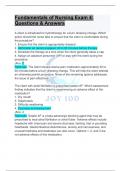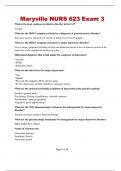Fundamentals of Nursing Exam 4 : Questions & Answers A client is scheduled for hydrotherapy for a burn dressing change. Which action should the nurse take to ensure that the client is comfortable during the procedure? 1. Ensure that the client is appropriately dressed 2. Administer an opioid analgesic 30 to 60 minutes before therapy 3. Schedule the therapy at a time when the client generally takes a nap 4. Assign an assistive personnel (AP) to stay with the client during the procedure (Ans- 2 Rationale : The client should receive pain medication approximately 30 to 60 minutes before a burn dressing change. This will help the client tolerate an otherwise painful procedure. None of the remaining options addresses the issue of pain effectively. The client with atrial fibrillation is prescribed sotalol AF. Which assessment finding indicates that the client is experiencing an adverse effect of the medication? 1. Dry mouth 2. Diaphoresis 3. Difficulty swallowing 4. Dizziness and feeling faint (Ans- 4 Rationale : Sotalol AF is a beta -adrenergic blocking agent that may be prescribed to treat atrial fibrillation or atrial flutter. Adverse effects include headache with chest pain and severe dizziness, fainting, fast or pounding heartbeats. Gastrointestinal disturban ces, anxiety and nervousness, and unusual tiredness and weakness can also occur. Options 1, 2, and 3 are not adverse effects of this medication. The nurse is reviewing the laboratory results for a client diagnosed with chronic heart failure (HF) who is receiving torsemide 5 mg orally daily. What value would indicate to the nurse that the client might be experiencing an adverse effect of the medicat ion? 1. A chloride level of 98 mEq/L 2. A sodium level of 135 mEq/L 3. A potassium level of 3.1 mEq/L 4. A blood urea nitrogen (BUN) level of 15 mg/dL (Ans- 3 Rationale : Torsemide is a loop diuretic. The medication can produce acute, profound water loss; volume and electrolyte depletion; dehydration; decreased blood volume; and circulatory collapse. Option 3 is the only option that indicates electrolyte depletion because the normal potassium level is 3.5 to 5.0 mEq/L. The normal chloride level is 98 to 107 mEq/L. the normal sodium level is 135 to 145 mEq/L. The normal BUN level ranges from 10 to 20 mg/dL. A client who is being treated for acute heart failure has the following vital signs: BP 85/50 mmHg; pulse 96 beats/min; respirations 26 breaths/min. The primary health care provider prescribes digoxin. To evaluate a therapeutic response to this medication, which changes in the client's vital signs would the nurse expect? 1. BP 85/50 mmHg, pulse 60 bpm, respirations 26 breaths/min 2. BP 98/60 mmHg, pulse 80 bpm, respirations 24 breaths/min 3. BP 130/70 mmHg, pulse 104 bpm, respirations 20 breaths/min 4. BP 110/40 mmHg, pulse 110 bpm, respirations 20 breaths/min (Ans- 2 Rationale : The main function of digoxin is inotropic. It produces increased myocardial contractility that is associated with an increased cardiac output. This causes a rise in the BP in a client with heart failure. Digoxin also has a negative chronotropic effect (d ecreases heart rate) and will therefore cause a slowing of the heart rate. As cardiac output improves, there should be an improvement in respirations as well. Options 1, 3, and 4 do not reflect the physiological changes attributed to this medication. A client diagnosed with hypertension has been taking a prescribed calcium channel blocker for approximately 2 months. The home care nurse monitoring the effects of therapy would determine that drug tolerance has developed if which is noted in the client? 1. Decrease in weight 2. Increased joint pain 3. Output greater than intake 4. Gradual rise in blood pressure (Ans- 4 Rationale : Drug tolerance can develop in a client taking an antihypertensive such as a calcium channel blocker, which is evident by rising blood pressure levels. The primary health care provider should be notified, who may then increase the medication dosage, chang e medication, or add a diuretic to the medication regimen. The client is also at risk of developing fluid retention, which would be manifested as dependent edema, intake greater than output, and an increase in weight. This would also warrant adding a diure tic to the course of therapy. Joint pain is not associated with this form of tolerance. The nurse is assessing a client with a history of angina who is being treated with a beta -adrenergic blocker. Which assessment findings would indicate that the client may be experiencing dose -related side effects of the medication? Select all that apply. 1. Dizziness 2. Bradycardia 3. Chest pain 4. Reflex tachycardia 5. Sexual dysfunction 6. Cardiac dysrhythmias (Ans- 1, 2, 5 Rationale: Beta -adrenergic blockers, commonly called beta blockers, are useful in treating cardiac dysrhythmias, mild hypertension, mild tachycardia, and angina pectoris. Side effects commonly associated with beta blockers are usually dose related and incl ude dizziness (hypotensive effect), bradycardia, hypotension, and sexual dysfunction (impotence). Options 3, 4, and 6 are reasons for prescribing a beta blocker; however, these are general side effects of alpha -adrenergic blockers. A client experiencing difficulty breathing and increased pulmonary congestion as a result of heart failure was prescribed furosemide 40 mg to be given intravenously. After an hour which assessment finding indicates that the therapy has been effective? 1. The lungs are now clear upon auscultation 2. The urine output has increased by 400 mL 3. The blood pressure has decreased from 118/64 to 106/62 mmHg 4. The serum potassium has decreased from 4.7 to 4.1 mEq (Ans- 1 Rationale : Furosemide is a diuretic. In this situation, it was given to decrease preload and reduce the pulmonary congestion and associated difficulty in breathing. Although all options may occur, option 1 is the reason that the furosemide was administered. The client diagnosed with chronic kidney disease is scheduled for hemodialysis. When would the nurse plan to administer the client's daily dose of enalapril to ensure its effectiveness? 1. During dialysis 2. Just before dialysis 3. The day after dialysis 4. Upon return from dialysis (Ans- 4 Rationale : Antihypertensive medications, such as enalapril, are administered to the client after hemodialysis. This prevents the client from becoming hypotensive during dialysis and also from having the medication removed from the bloodstream by dialysis. There is no rationale for waiting a full day to resume medication. This would lead to ineffective control of the blood pressure.





